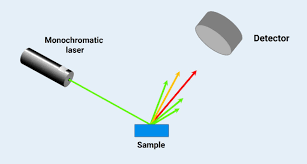
Raman spectroscopy, a powerful analytical technique, has revolutionized various fields of science and technology. By providing valuable insights into the molecular structure and composition of materials, Raman spectroscopy has found its applications in numerous disciplines.
In this blog post, we will explore ten captivating applications of Raman Spectroscopy that highlight its versatility and significance in different domains.
Pharmaceutical Analysis
Raman spectroscopy plays a crucial role in pharmaceutical research and development. It enables rapid and non-destructive identification of drug compounds, monitoring of drug interactions, and evaluation of drug formulations.
By providing valuable information about chemical composition and crystal structure, Raman spectroscopy ensures drug quality and efficacy. It helps detect impurities and polymorphic forms, as well as the analysis of drug stability, dissolution, and bioavailability.
Forensic Science
In forensic investigations, Raman spectroscopy assists in identifying and analyzing trace evidence. It can differentiate between fibers, paints, and drugs, aiding in criminal investigations.
Raman spectroscopy also examines questioned documents, identifies counterfeit products, and analyzes gunshot residue. Its ability to provide non-destructive analysis is precious in preserving evidence for future research.
Environmental Monitoring
Raman spectroscopy contributes to environmental monitoring and analysis. It helps identify pollutants in air, water, and soil samples, such as heavy metals and organic compounds.
Raman spectroscopy-based sensors enable real-time monitoring of environmental parameters, assisting in pollution control and resource management. It has been employed in monitoring air quality, analyzing water contamination, and studying the composition of soil and sediments.
Art and Cultural Heritage Conservation
Preserving and analyzing artwork and cultural artifacts require non-destructive techniques. Raman spectroscopy offers a valuable tool for identifying pigments, dyes, and binders used in paintings.
It aids in studying degradation processes, identifying counterfeit artifacts, and guiding restoration efforts while ensuring minimal damage to the original materials. Raman spectroscopy has been instrumental in the authentication of artworks, the characterization of ancient pigments, and studying the effects of environmental factors on cultural heritage objects.
Food and Agriculture
Raman spectroscopy finds applications in food quality control and agricultural research. It can identify contaminants, detect food adulteration, and analyze the nutritional content of food products.
Raman spectroscopy also helps monitor crop health, assess soil composition, and optimize fertilizer usage. Its ability to provide rapid and non-destructive analysis has been employed in assessing food safety, authentication of agricultural products, and studying plant physiology.
Materials Science
In materials science, Raman spectroscopy provides valuable insights into materials’ structural and chemical properties. It helps analyze crystal structures, study phase transitions, and investigate defects and impurities.
Raman spectroscopy is widely used in characterizing graphene, nanomaterials, semiconductors, and polymers. It has been instrumental in understanding the vibrational properties of materials, studying their mechanical behavior, and developing advanced materials for various applications.
Biomedical Research
Raman spectroscopy has significant implications in biomedical research and diagnostics. It enables label-free analysis of cells, tissues, and biomolecules, offering insights into disease progression, cellular metabolism, and drug response.
Raman spectroscopy is also used for cancer diagnosis, tissue imaging, and studying drug delivery systems. Its ability to provide molecular information at the cellular level has opened up new avenues for understanding diseases, developing personalized medicine, and monitoring therapeutic interventions.
Geology and Mineralogy
Raman spectroscopy plays a vital role in geology and mineralogy by identifying and characterizing minerals. It aids in studying geological processes, mineral identification, and the analysis of geological samples.
Raman spectroscopy is particularly useful in analyzing gemstones, studying meteorites, and identifying mineral phases in rocks. Its ability to provide chemical and structural information about minerals has advanced our understanding of Earth’s geological history and mineral resources.
Nanotechnology
Raman spectroscopy is indispensable in nanotechnology research and development. It provides a non-invasive tool for characterizing nanoparticles, nanomaterials, and nanostructures.
Raman spectroscopy enables the study of size-dependent properties, surface-enhanced Raman scattering (SERS), and monitoring of nanoscale processes. Its ability to probe nanoscale materials has contributed to nanofabrication, nanomedicine, and nanophotonics advancements.
Pharmaceuticals and Drug Delivery
Raman spectroscopy is used in pharmaceutical manufacturing to ensure the quality and consistency of drug formulations. It helps in process monitoring, detection of impurities, and assessing drug stability.
Raman spectroscopy also aids in studying drug delivery systems, such as nanoparticles and liposomes, enabling precise drug targeting. Its non-destructive nature and ability to provide real-time information have made it an essential tool in pharmaceutical development, ensuring the safety and efficacy of drug products.
Conclusion
The applications of Raman spectroscopy span a wide range of fields, from pharmaceuticals to art conservation, from environmental monitoring to nanotechnology. Its ability to provide non-destructive, label-free analysis makes it an invaluable tool for researchers and scientists worldwide.
With ongoing technological advancements, Raman spectroscopy continues to push the boundaries of scientific exploration and discovery, opening new avenues for innovation in diverse disciplines. The versatility of Raman spectroscopy ensures its continued importance in solving complex scientific and technological challenges across various industries and research domains.

Leave a Reply